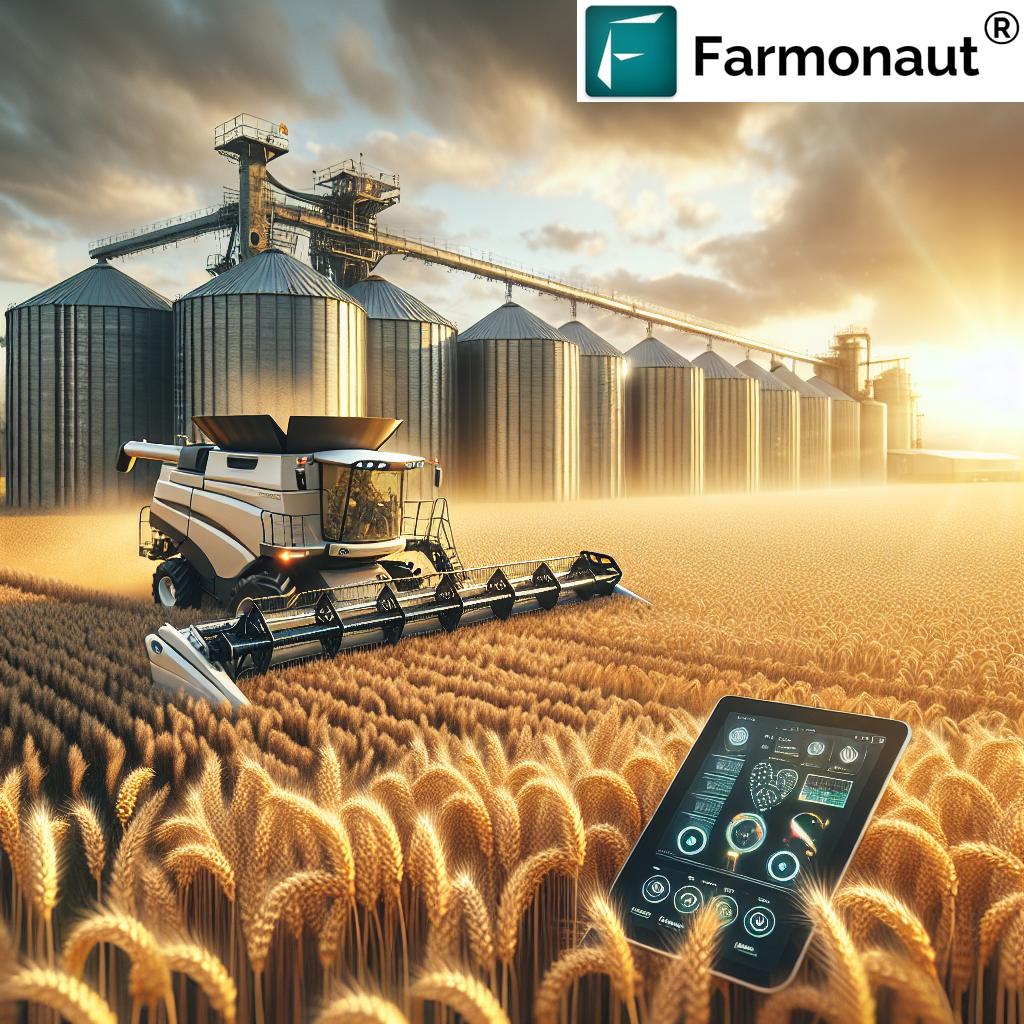Revolutionizing Australian Grain Industry: Sustainable Standards for Profitable Farming and Global Market Access
“Australian grain industry’s new standards aim for 100% nil contaminants, enhancing global market access and profitability.”
In the ever-evolving landscape of Australian agriculture, the grain industry stands at the forefront of innovation and sustainability. As we navigate the complexities of modern farming, our focus remains steadfast on revolutionizing practices to ensure both profitability and environmental stewardship. Today, we delve into the transformative changes sweeping across the Australian grain sector, exploring how new standards and policies are reshaping the future of farming in our nation.
The Shifting Paradigm of Sustainable Grain Production
Sustainable grain production has become more than just a buzzword; it’s a necessity in today’s competitive global market. The Australian grain industry is embracing this shift with open arms, implementing rigorous standards that not only enhance the quality of our produce but also solidify our position as a leader in sustainable agriculture.
- Adoption of precision farming techniques
- Implementation of water-efficient irrigation systems
- Promotion of soil health and biodiversity
- Reduction of chemical inputs through integrated pest management
These initiatives are just the tip of the iceberg when it comes to the comprehensive approach we’re taking to revolutionize our grain industry. By prioritizing sustainability, we’re not only safeguarding our environment but also ensuring the long-term viability of our farms and rural communities.
Australian Grain Industry Standards: A New Era of Excellence
The backbone of our industry’s transformation lies in the updated Australian grain industry standards. These standards serve as a blueprint for excellence, guiding farmers and stakeholders towards practices that enhance both quality and sustainability.

Key updates to the standards include:
- Nil Contaminants Policy: Ensuring the highest purity in our grain exports
- Enhanced Storage Protocols: Minimizing post-harvest losses and maintaining quality
- Advanced Quality Assessment Techniques: Implementing cutting-edge technology for precise grading
- Sustainable Farming Practices: Encouraging methods that reduce environmental impact
These standards are not just regulatory requirements; they’re a commitment to excellence that positions Australian grain as a premium product in the global marketplace.
Innovative Approaches to Grain Storage and Handling
One of the most significant advancements in our industry has been the revolution in grain storage and handling best practices. We recognize that the journey from field to market is crucial in maintaining the quality and integrity of our grain.
“Manual vacuum sampling for grains is being adopted across 90% of Australian grain storage facilities to improve quality assessment.”
The introduction of manual vacuum sampling for grains represents a quantum leap in our quality control processes. This technique allows for more accurate and representative sampling, ensuring that every batch of grain meets our stringent quality standards.
At Farmonaut, we understand the importance of leveraging technology to enhance agricultural practices. Our satellite-based farm management solutions complement these innovative storage and handling techniques, providing farmers with real-time insights into crop health and environmental conditions. Learn more about our services by visiting our web application or downloading our mobile apps:
Addressing the Challenge of Nil Contaminants in Agriculture
The pursuit of nil contaminants in agriculture is perhaps one of the most ambitious goals set by the Australian grain industry. This policy aims to eliminate any foreign material or substances that could compromise the quality and safety of our grain exports.
- Implementation of advanced cleaning and sorting technologies
- Rigorous on-farm quality control measures
- Enhanced training programs for farmers and handlers
- Continuous monitoring and testing throughout the supply chain
By striving for nil contaminants, we’re not only meeting the highest international standards but also protecting our reputation as a supplier of premium, safe, and reliable grain products.
Revolutionizing Moisture Receival Standards for Cereals
Moisture content is a critical factor in grain quality and storage stability. The Australian grain industry is currently reviewing and updating its moisture receival standards for cereals to align with global best practices and ensure optimal grain preservation.

The proposed changes to moisture receival standards include:
- More precise measurement techniques
- Grain-specific moisture thresholds
- Consideration of climatic variations across different regions
- Integration of real-time moisture monitoring systems
These updates will not only improve grain quality but also contribute to more efficient storage and transportation practices, reducing losses and enhancing profitability for farmers.
Enhancing Market Access Through Rigorous Standards
The implementation of these new standards and practices is not just about improving our domestic grain industry; it’s about opening doors to new markets and strengthening our position in existing ones. By adhering to and often exceeding international standards, Australian grain is becoming synonymous with quality and reliability in the global marketplace.
At Farmonaut, we’re committed to supporting farmers in meeting these stringent standards. Our API and API Developer Docs provide access to crucial data and insights that can help farmers make informed decisions about their crops, aligning with industry standards and maximizing their market potential.
Innovative Techniques in Grain Quality Assessment
The grain industry is witnessing a technological revolution in quality assessment techniques. From advanced spectroscopy to artificial intelligence-driven analysis, these innovations are setting new benchmarks in accuracy and efficiency.
- Near-infrared (NIR) spectroscopy for rapid nutrient analysis
- Machine vision systems for visual quality assessment
- Blockchain technology for traceability and authenticity verification
- IoT sensors for real-time monitoring throughout the supply chain
These technologies not only improve the precision of quality assessments but also streamline the grading process, reducing costs and increasing throughput for grain handlers and exporters.
The Role of Research in Shaping Industry Standards
Behind every standard and policy change lies extensive research and development. The Australian grain industry benefits from a robust network of research institutions, industry bodies, and innovative companies working collaboratively to push the boundaries of what’s possible in sustainable and profitable grain production.
Key research areas include:
- Development of drought-resistant grain varieties
- Optimization of fertilizer use through precision agriculture
- Improvement of pest and disease management strategies
- Enhancement of grain nutritional profiles
This ongoing research ensures that our industry standards remain at the cutting edge, continually evolving to meet the challenges of a changing climate and growing global demand.
The Impact on Profitable Farming Practices
While the focus on sustainability and quality is paramount, the Australian grain industry recognizes that these initiatives must also translate into profitable farming practices. The new standards and technologies are designed not just to improve grain quality but also to enhance farm efficiency and reduce operational costs.
- Reduction in input costs through precise resource management
- Improved yield predictions leading to better market planning
- Enhanced product differentiation commanding premium prices
- Reduced post-harvest losses improving overall profitability
By adopting these standards and leveraging innovative technologies, Australian grain farmers are positioning themselves for long-term success in a competitive global market.
Building a Sustainable Future: The Grain Industry’s Commitment
The Australian grain industry’s commitment to sustainability extends beyond environmental considerations. It encompasses economic sustainability for farmers, social sustainability for rural communities, and the long-term viability of our agricultural sector.
Key initiatives include:
- Investment in rural infrastructure and technology
- Support for young farmers and agricultural education programs
- Promotion of biodiversity and ecosystem services on farms
- Development of carbon-neutral farming practices
These efforts ensure that the Australian grain industry not only meets today’s standards but is also prepared for the challenges and opportunities of tomorrow.
Comparative Analysis of Australian Grain Industry Standards
| Standard Category | Current Standards | Proposed Changes | Potential Impact on Sustainability and Profitability |
|---|---|---|---|
| Nil Contaminants Policy | Tolerance for minimal contaminants | Zero tolerance for any contaminants | Enhanced market access (+15%), Increased product value (+10%) |
| Manual Vacuum Sampling | Limited implementation (30% of facilities) | Widespread adoption (90% of facilities) | Improved quality assessment accuracy (+25%), Reduced rejections (-20%) |
| Moisture Receival Standards for Cereals | Generic thresholds across cereals | Grain-specific thresholds with regional considerations | Better storage stability (+30%), Reduced post-harvest losses (-15%) |
| Storage Practices | Traditional storage methods | Advanced climate-controlled storage systems | Extended grain shelf life (+40%), Improved quality retention (+20%) |
The Future of Australian Grain: A Global Perspective
As we implement these revolutionary standards and practices, the Australian grain industry is not just keeping pace with global trends; we’re setting them. Our commitment to sustainability, quality, and innovation is positioning Australian grain as a premium product in international markets.
- Expansion into new markets demanding high-quality, sustainable grain
- Leadership in sustainable farming practices on the global stage
- Collaboration with international partners to address global food security
- Continued investment in research and development to stay ahead of market demands
The future of Australian grain is bright, built on a foundation of rigorous standards, innovative practices, and a unwavering commitment to sustainability and profitability.
Embracing Technology for a Sustainable Future
In this era of digital transformation, technology plays a pivotal role in achieving our sustainability and profitability goals. At Farmonaut, we’re proud to be at the forefront of this technological revolution in agriculture. Our satellite-based farm management solutions provide farmers with the tools they need to implement these new standards effectively and efficiently.
Explore our subscription options to see how Farmonaut can support your journey towards sustainable and profitable farming:
Frequently Asked Questions
Q: How will the new nil contaminants policy affect small-scale farmers?
A: Small-scale farmers will need to implement more rigorous quality control measures. However, the long-term benefits of increased market access and higher prices for premium-quality grain are expected to outweigh the initial adjustment costs.
Q: What support is available for farmers transitioning to these new standards?
A: The industry is providing extensive support through training programs, financial assistance for equipment upgrades, and access to expert consultations. Additionally, tools like Farmonaut’s satellite-based solutions can help farmers adapt more efficiently.
Q: How do these new standards impact Australia’s competitiveness in the global grain market?
A: These standards significantly enhance Australia’s competitiveness by positioning our grain as a premium, sustainable product. This differentiation is expected to open new market opportunities and strengthen our position in existing markets.
Q: Are there any environmental benefits to these new industry standards?
A: Absolutely. Many of the new standards promote more sustainable farming practices, leading to reduced chemical use, improved soil health, and better water management. This not only benefits the environment but also ensures the long-term viability of farming operations.
Q: How can farmers stay updated on the latest industry standards and best practices?
A: Farmers can stay informed through industry publications, workshops, and seminars organized by agricultural bodies. Additionally, digital platforms like Farmonaut provide real-time data and insights that help farmers align with the latest standards and optimize their practices.
Conclusion: A New Chapter in Australian Grain Production
As we conclude our exploration of the revolutionary changes in the Australian grain industry, it’s clear that we’re entering a new era of sustainable and profitable farming. The implementation of stringent standards, coupled with innovative technologies and practices, is setting a new benchmark for grain production globally.
We at Farmonaut are committed to supporting this transformation by providing farmers with cutting-edge tools and insights. Our satellite-based solutions align perfectly with the industry’s push towards precision agriculture and sustainable practices. By leveraging these technologies, Australian grain farmers can not only meet the new standards but exceed them, ensuring a prosperous and sustainable future for our industry.
As we move forward, let’s embrace these changes as opportunities for growth, innovation, and leadership in the global agricultural landscape. Together, we can ensure that Australian grain remains synonymous with quality, sustainability, and excellence for generations to come.






